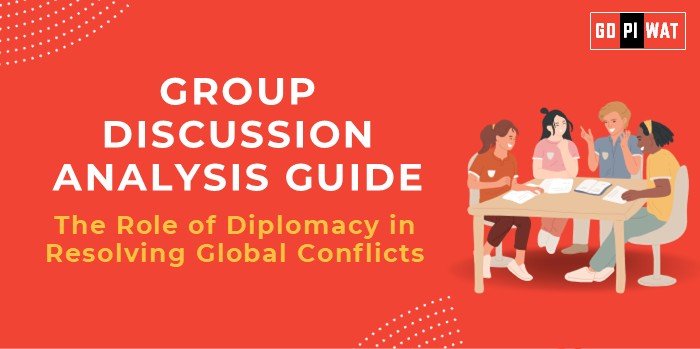📋 Group Discussion Analysis Guide
🌍 The Role of Diplomacy in Resolving Global Conflicts
🛡️ Introduction to Diplomacy in Global Conflicts
Opening Context: “Diplomacy has been a cornerstone of international relations, serving as the preferred tool to prevent wars, foster alliances, and build peace in a world marked by geopolitical tensions.”
Topic Background: Diplomacy evolved as a strategic tool from ancient treaties to the modern United Nations Charter of 1945. Recent examples, such as the Abraham Accords (2020) and the Russia-Ukraine negotiations, highlight its relevance in addressing crises ranging from territorial disputes to climate change.
📊 Quick Facts and Key Statistics
- United Nations Membership: 193 countries united for collective diplomacy.
- Mediated Peace Agreements (1990-2022): Over 50 significant treaties led by international mediators.
- Conflict Reduction via Diplomacy: Conflicts reduced by 20% globally through UN interventions (UN Reports, 2023).
- Global Diplomatic Spend: Estimated $15 billion annually, underscoring its priority.
👥 Stakeholders and Their Roles
- Governments: Implement and negotiate policies.
- International Organizations: UN, NATO, and others mediate and enforce resolutions.
- NGOs: Promote grassroots-level dialogue and humanitarian aid.
- Media: Shapes public opinion and exposes conflict realities.
🏆 Achievements and Challenges
✨ Achievements:
- Iran Nuclear Deal (2015): Curbed nuclear proliferation.
- Paris Climate Accord (2015): Mobilized global environmental cooperation.
- Ethiopia-Eritrea Peace (2018): Resolved a 20-year conflict, earning a Nobel Prize.
- ASEAN Initiatives: Reduced regional tensions in South East Asia.
⚠️ Challenges:
- Lack of Trust: Persistent in regions like the Middle East.
- Economic Sanctions: Often escalate tensions rather than resolve them.
- Polarization: Rising nationalism hampers collaborative efforts.
🌏 Global Comparisons:
- Success: Norway’s mediation model in Sri Lanka and Colombia.
- Challenges: Limited success in Yemen and Syria due to fragmented factions.
📖 Case Studies:
- Abraham Accords: Fostered unprecedented Arab-Israeli cooperation.
- Russia-Ukraine Crisis: Limited success despite significant diplomatic efforts.
🔍 Structured Arguments for Discussion
- Supporting Stance: “Diplomacy prevents irreversible escalations, as seen in the Cuban Missile Crisis (1962).”
- Opposing Stance: “Diplomacy often delays action, enabling aggressors, as observed in pre-World War II appeasement policies.”
- Balanced Perspective: “While diplomacy can be slow and complex, it remains our best hope for sustainable peace.”
💡 Effective Discussion Approaches
- Opening Approaches:
- Quote by John F. Kennedy: “Let us never negotiate out of fear, but let us never fear to negotiate.”
- Mention key successes like the Paris Agreement.
- Counter-Argument Handling:
- “Economic sanctions may escalate tensions, but pairing them with open channels of communication can achieve results.”
- “Historical failures in diplomacy highlight gaps, not its irrelevance.”
🔎 Strategic Analysis of Strengths and Weaknesses
- Strengths: Builds consensus, prevents wars, fosters cooperation.
- Weaknesses: Time-intensive, susceptibility to power imbalances.
- Opportunities: Emerging technologies like AI in conflict forecasting.
- Threats: Rising authoritarianism and diminished trust in global institutions.
📈 Connecting with B-School Applications
- Real-World Applications:
- Conflict resolution frameworks in operations or CSR.
- Negotiation techniques applicable in management roles.
- Sample Interview Questions:
- “Can diplomatic strategies resolve trade wars effectively?”
- “How would you balance competing stakeholder interests?”
- Insights for B-School Students:
- Understanding negotiation dynamics.
- Leveraging historical insights in corporate dispute resolutions.


